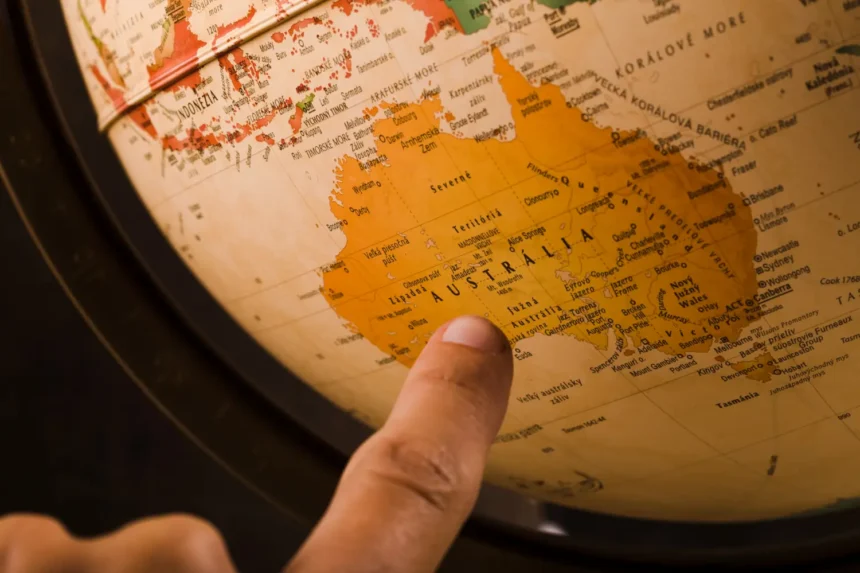Introduction
Australia is a vast landmass, the home to kangaroos hopping across arid deserts, koalas clinging to eucalyptus trees in lush rainforests, and vibrant coral reefs teeming with life. But is Australia an island? Is Australia the world’s largest island, or is it something more?
The questions might seem straightforward, but they open a fascinating debate at the intersection of geography and geology. Australia is often called an “island continent,” which hints at its unique status.
While it’s surrounded by water, a key characteristic of islands, its vast size and distinct geological composition raise questions about whether it truly fits the definition.
In this article, we’ll dive into the criteria defining islands and continents, exploring Australia’s geological history and unique characteristics. We’ll examine the arguments for both sides of the “Is Australia an island?” debate and consider the broader implications for our understanding of the Earth’s landmasses.
By the end, you’ll have a clearer picture of this intriguing geographical puzzle and perhaps a newfound appreciation for our planet’s diverse and complex nature.
Background Information
Australia is located between the southern and eastern hemispheres. It comprises mainland Australia, Tasmania, New Guinea, the Aru Islands, Ashmore and Cartier Islands, numerous Coral Sea islands, and several nearby islands.
Situated in the tropical region of Oceania, Australia is the tiniest of the seven traditional continents. It includes a continental shelf divided by significant bodies of water, such as the Arafura Sea and Torres Strait between mainland Australia and New Guinea and the Bass Strait between mainland Australia and Tasmania.

The region also features diverse landscapes, including glaciers in some southernmost territories. To the west is the Great Australian Desert, one of the world’s driest regions. All these landforms make Australia a unique landmass.
Read also: How is the West Australian Desert Formed?
Defining Islands: Size, Isolation, and Geology
Size and scale
Oceania, including Australia, the smallest continent, boasts 34,218 km of coastline and encompasses an exclusive economic zone of 8,148,250 square km. Mainland Australia lies between latitudes 90S and 440S and longitudes 1120 E and 1540E.
Size plays a crucial role in determining whether Australia is an island. So, how big does a landmass need to qualify as an island? Interestingly, there’s no single definitive answer. Some definitions stipulate that an island must be smaller than a continent, yet the criteria for continents can also be subjective.
The smallest recognized island is Bishop Rock, a tiny outcrop in the Atlantic Ocean measuring a mere 46 by 16 meters. On the slightly larger side, we have Just Room Enough Island in the St. Lawrence River, which, as its name suggests, barely accommodates a single house and a tree. These minuscule landforms fit the island’s definition.
This massive size disparity raises the question: Is Australia simply too large to be classified as an island? While some may argue that its immense scale disqualifies it from island status, others point out that being surrounded by water is a fundamental characteristic of islands, regardless of size.
While size is a significant factor, it’s not the only criterion for determining whether Australia is an island. We must also consider its isolation, geological composition, and other distinguishing features. Only by examining all these aspects can we truly answer the question, “Is Australia an island?”
Isolation: Surrounded by Water
A fundamental characteristic often associated with islands is their isolation, being surrounded by water. However, the question “Is Australia an island?” prompts a deeper examination of this criterion.
Oceania primarily consists of a plateau overlapped by shallow seas, such as the Arafura Sea and Torres Strait between mainland Australia and New Guinea and the Bass Strait between mainland Australia and Tasmania.
Geological forces, including tectonic plate movements, have shaped Australia’s ancient history. Deserts and arid regions also influence the landscape. It’s separated from Asia by the Timor and Arafura Seas, from Antarctica by the Southern Ocean, and from Africa by the vast Indian Ocean.
The nearest major landmass, Southeast Asia, lies over 2,500 kilometers away. This geographical distance and the surrounding oceans support the argument for Australia as an island.
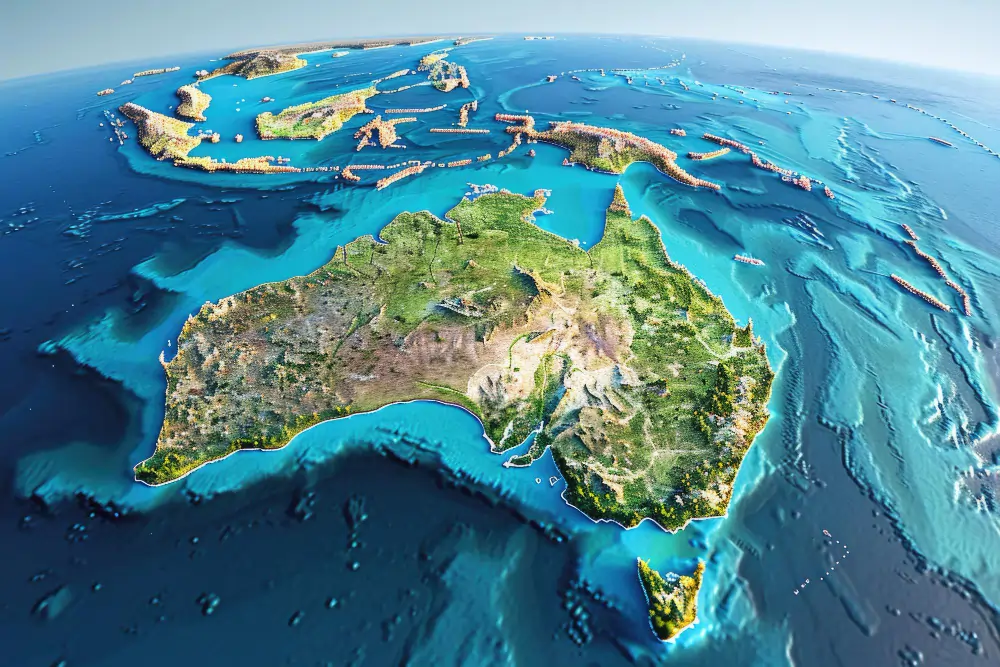
However, the question of “Is Australia an Island?” is not as straightforward as it seems. Australia sits atop a large continental shelf connecting it to New Guinea and Tasmania islands. This raises the question of whether Australia should be considered a single, isolated landmass or part of a larger continental structure.
Additionally, tectonic plates, massive slabs of Earth’s crust and upper mantle, play a crucial role in shaping continents and islands. The tectonic plate on which Australia sits, the Australian Plate, is separate from those of other continents; its connection to the broader Indo-Australian Plate raises questions about whether Australia is truly isolated in a geological sense.
In conclusion, while Australia is geographically isolated from other major landmasses, the presence of a continental shelf and its connection to Zealandia through tectonic plates complicate the “Is Australia an Island?” debate. To reach a definitive answer, we must consider other factors, such as Australia’s geological composition and the broader definitions of islands and continents.
Read also: Antarctica from Space: A Visual Story of a Continent in Crisis
Read also: Desert Food Web: Uncover the Secrets of Life in Extreme Environments
Geological Considerations
Whether Australia is an island or a continent delves deeper than its size and isolation. A critical factor lies beneath our feet—the rocks forming the landmass. To determine if Australia truly stands as a continent, we must explore the geological makeup of its crust and compare it to other land masses.
Continental Crust vs. Oceanic Crust
Earth’s outermost layer, the crust, comprises two distinct types: continental and oceanic crust. Understanding their differences is key to unraveling the mystery of “Is Australia an Island?”
Continental Crust: This crust is thicker, less dense, and primarily composed of granite. It forms the foundation of continents, including the familiar landmasses we inhabit. The continental crust is buoyant and tends to “float” higher on the Earth’s mantle.
Oceanic Crust: Thinner, denser, and composed mainly of basalt, the oceanic crust underlies the ocean floors. It is relatively young compared to the continental crust and is constantly being created and destroyed through tectonic plate movements.
Read also: Explore the Earth’s Interior: A Dynamic World Beneath
Read also: Types of Rocks: 3 Processes that Shatter and Transform
The Geological Composition of Australia
Examining Australia’s geological composition reveals a striking similarity to the continental crust. Most of Australia’s landmass comprises ancient, stable rock formations, predominantly granite, that date back billions of years. This aligns with the characteristics of the continental crust, suggesting that Australia’s geological roots are firmly planted in the continental family.
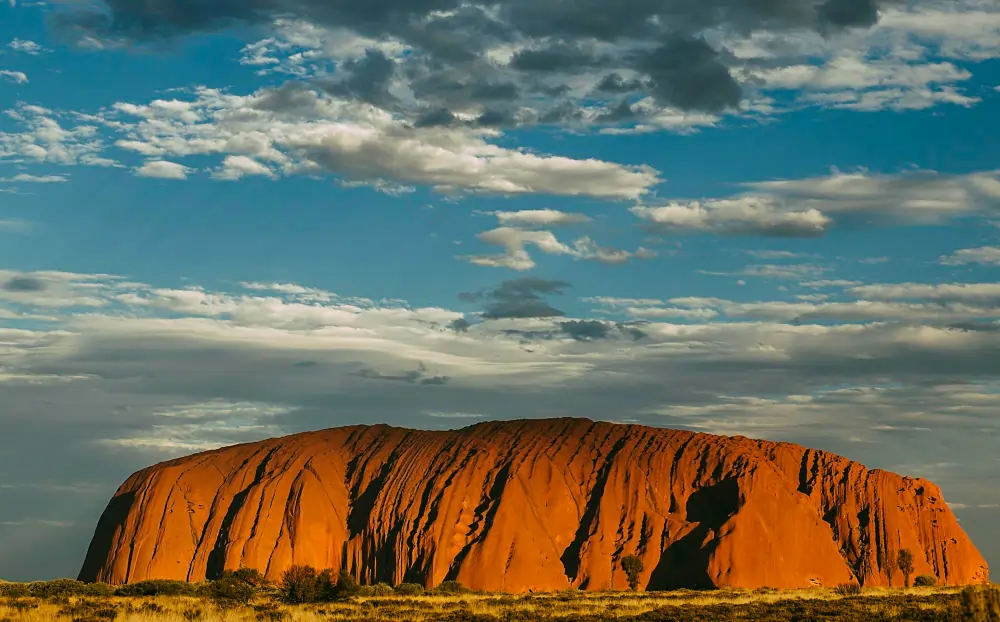
However, there’s a twist. Some parts of Australia, particularly the northern and eastern regions, show evidence of the oceanic crust. This is attributed to the region’s complex geological history, including interactions with tectonic plates and volcanic activity. Despite these oceanic patches, most of Australia’s landmass comprises continental crust.
Defining Continents
The question “Is Australia an Island?” hinges on how we define a continent. Traditionally, continents are seen as large, distinct landmasses separated by oceans. This model identifies seven continents: Africa, Asia, Antarctica, Europe, North America, South America, and Australia. However, is this the only way to view continents?
Read also: Continental Drift Theory: 5 Mind-Blowing Clues That Reveal Earth’s Secret Past
Traditional View
In the classic model, Australia comfortably fits as the smallest continent. It boasts a vast land area, diverse ecosystems, and a unique cultural identity. Yet, its isolation and smaller size than other continents raise questions about its status. Could it simply be a giant island?
Read also: Ecosystem | Definition, Components, and 5 Important Types of Ecosystem
Geological Perspective: Plate Tectonics
However, the study of plate tectonics has challenged this traditional view. Continents are now understood as large, distinct landmasses primarily composed of continental crust thicker and less dense than the oceanic crust that forms the ocean floor. These landmasses sit atop tectonic plates, which are constantly moving and interacting.
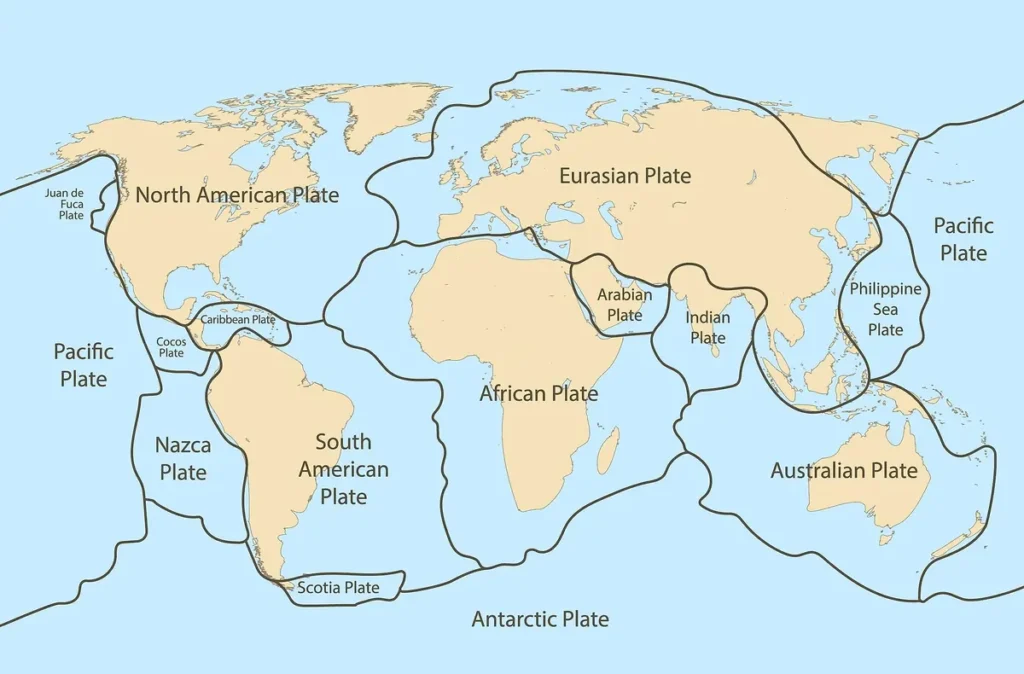
This geological perspective blurs the lines between continents and islands. For instance, some geologists argue that Europe and Asia are actually a single continent, Eurasia, as they share the same continental plate.
Read also: Our Dynamic Planet: How Plate Tectonics Shapes the World
The Case for Zealandia: A Hidden Continent?
The discovery of Zealandia, a vast, mostly submerged landmass east of Australia, has further complicated the definition of a continent. Zealandia meets the geological criteria for a continent, possessing continental crust and being geologically distinct from Australia. If recognized as a continent, it would challenge Australia’s status as the smallest continent and raise questions about its relationship with Zealandia.
So, is Australia an island or a continent? The answer depends on whether we prioritize traditional definitions or adhere to a strict geological perspective. As we delve further into Australia’s unique characteristics, we’ll uncover more clues to help us solve this intriguing geographical puzzle.
Is Australia an Island?
Whether Australia is an island or a continent goes beyond mere semantics. Australia’s unique characteristics, shaped by its geographic isolation and geological history, contribute significantly to the debate surrounding its classification. Is Australia an island with continental proportions, or does it deserve full-fledged continental status? Let’s explore some key aspects that set Australia apart.
Biodiversity
Australia is renowned for its remarkable biodiversity, often called a “natural laboratory of evolution.” Its long-term isolation from other landmasses has resulted in a high degree of endemism, with most of its plant and animal species found nowhere else on Earth.

From iconic marsupials like kangaroos and koalas to bizarre monotremes like the platypus and echidna, Australia’s wildlife is a testament to its unique evolutionary path. This biological distinctiveness has sparked ongoing scientific research and conservation efforts to protect these irreplaceable treasures.
Read also: Biodiversity Crisis: 5 Shocking Ways We’re Losing Nature’s Riches
Read also: 6 Reasons Why Is the Great Barrier Reef Important?
Cultural Perspective of Australia
The question “Is Australia an island?” extends beyond geography and into cultural identity. Australia’s geographic isolation has fostered a strong national identity and self-reliance. The so-called “island mentality” – a perceived tendency towards insularity and independence – is often attributed to the country’s unique position.
While influenced by Britain’s Westernized traditions, Australia’s culture is also significantly shaped by the unique characteristics of the Australian continent. This includes the rich cultural contributions from Aboriginals, Torres Strait Islanders, and other Oceania communities.
The most ancient cultural traditions belong to Australia’s Aboriginal and Torres Strait Islander peoples. The primary language spoken in Australia is Australian English.
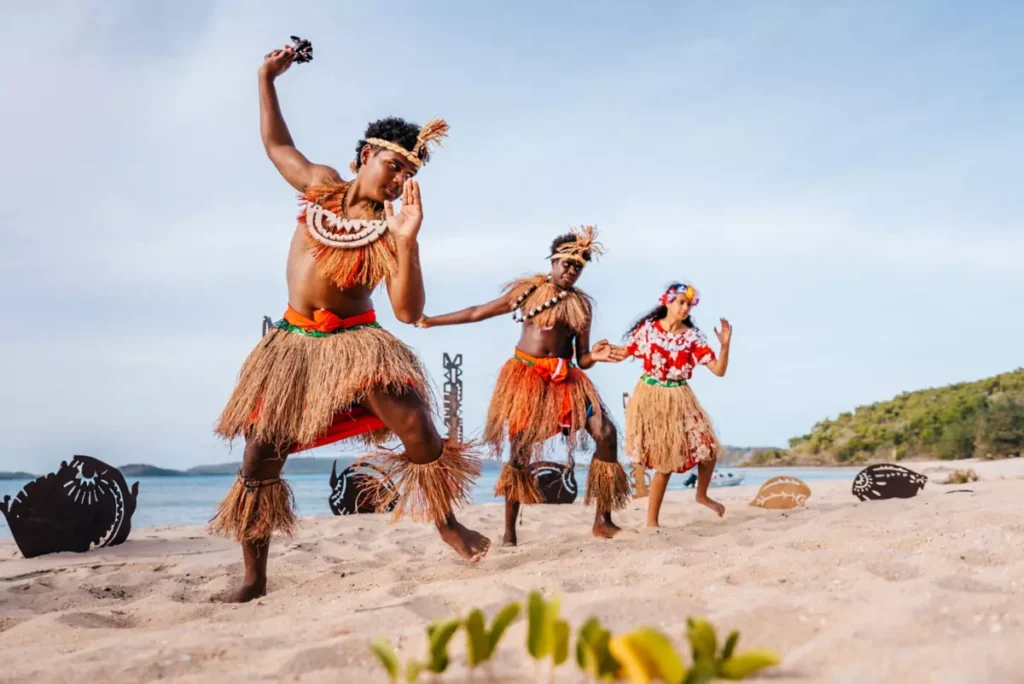
Read also: Negative Effects of Climate Change on Indigenous People of the World
Political and Economic Considerations
Australia’s status as an independent nation and its economic landscape are intertwined with the island vs. continent debate. As a sovereign country, Australia enjoys political autonomy and a distinct national identity.
However, its economic fortunes are often tied to global trade and geographic location. Whether being classified as an island or a continent impacts trade relations, resource management, or international standing remains a complex question.
Comparison of Australia with Greenland
Although Australia is the smallest continent, it is more than three times the size of Greenland, the largest island. Oceania’s Australia spans an impressive 7,741,220 square kilometers, while Greenland covers approximately 2,166,086 square kilometers.
Australia is on its tectonic plate, making it smaller in population but more geographically significant. In contrast, Greenland is on the North American tectonic plate.
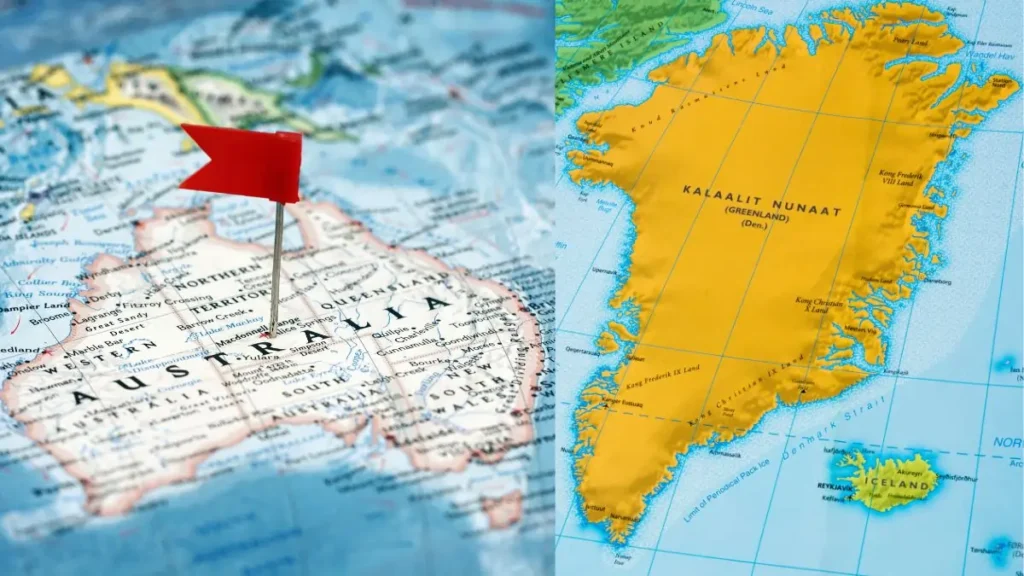
Australia’s flora and fauna are vast and diverse, unlike Greenland’s. Greenland, while the largest island, lacks the diversity found in Oceania.
Australia’s distinct culture and political structure also contrast with Greenland, making it an autonomous territory.
Additionally, Australia boasts unique ecosystems, including vast deserts and tropical rainforests, in contrast to Greenland’s rugged terrain dominated by glaciers and sparse vegetation.
Read also: Climate Change and Greenland Glacial Melt – 5 Alarming Effects
Conclusion
As we’ve journeyed through the complexities of geography and geology, the question “Is Australia an island?” remains a subject of debate. While Australia undeniably exhibits characteristics of both islands and continents, the consensus leans towards its classification as a continent due to its vast size, unique biodiversity, and geological composition.
Ultimately, whether we label Australia an island or a continent depends on the criteria we prioritize. Australia’s importance as a unique and diverse landmass is undeniable regardless of its official designation.
Recognizing its continental status may be crucial for understanding its ecological significance and conserving its irreplaceable ecosystems. The debate over whether Australia is an island serves as a reminder of the complex and ever-evolving nature of geographical definitions.
FAQs
1. Is Australia the largest island in the world?
No, Australia is considered a continent, not an island. Greenland holds the title of the world’s largest island.
2. Why do some people call Australia an island continent?
Australia is surrounded by water, a characteristic of islands, but its large size and unique geology align it more with continents. Hence, the term “island continent.
3. What makes a continent different from an island?
Continents are generally much larger than islands and have a distinct geological structure called continental crust. Islands can be formed in various ways, including volcanic activity or the separation of land masses.
4. Is Australia on its tectonic plate?
Yes, Australia sits on the Australian Plate, which is separate from other major tectonic plates.
5. Does Australia have any islands surrounding it?
Australia has many islands surrounding it, including Tasmania, which is considered its largest island state.
6. What is Zealandia, and how does it relate to Australia?
Zealandia is a mostly submerged continent located near Australia. Although it is geologically distinct from Australia, it shares some geological history.
7. What makes Australia different from other continents?
Australia has a unique geological history, diverse ecosystems with endemic species, and a cultural identity shaped by its geographic isolation.
References
- Island. (n.d.). Nationalgeographic.org. Retrieved May 20, 2024, from https://education.nationalgeographic.org/resource/island/
- Modesty, A. (n.d.). Australian Society & Culture. Edu.au. Retrieved May 20, 2024, from https://www.wssc.vic.edu.au/wp-content/uploads/2014/06/Orientation-Australian-Culture.pdf
- Australia and Oceania: Physical geography. (n.d.). Nationalgeographic.org. Retrieved May 20, 2024, from https://education.nationalgeographic.org/resource/oceania-physical-geography/


